Application of insecticide and fumigant is done at the time the grain is being loaded into the storage bins either at reception of new crop or during inter-bin transfer. The recommended dosage must be used throughout and the safety regulation adhered to always. Trained personnel should carry out application of fumigants and pesticides.
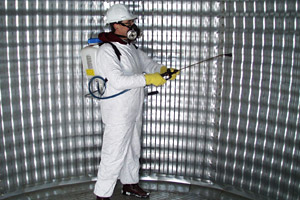
Chemical Insecticide Types
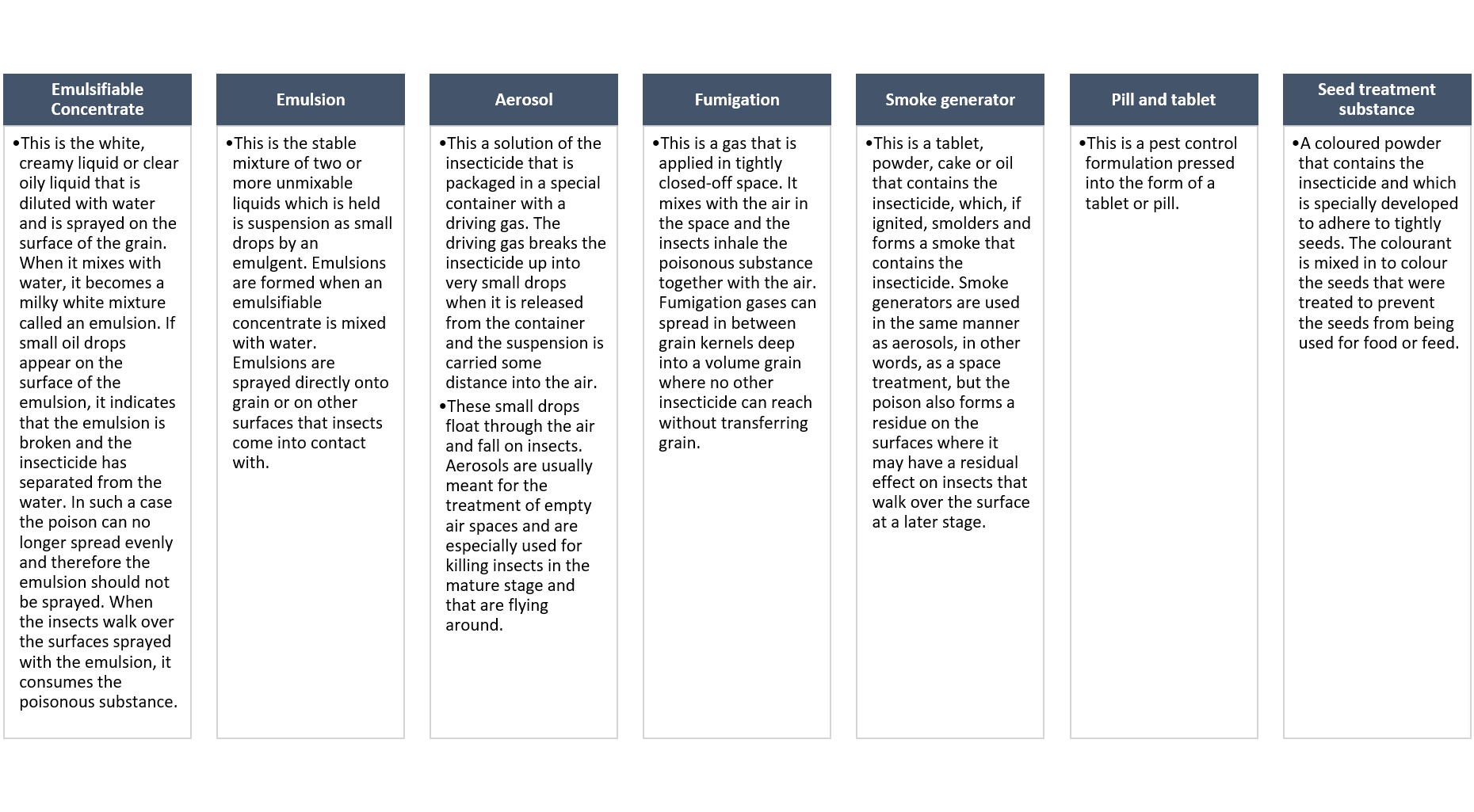
Disinfection Methods
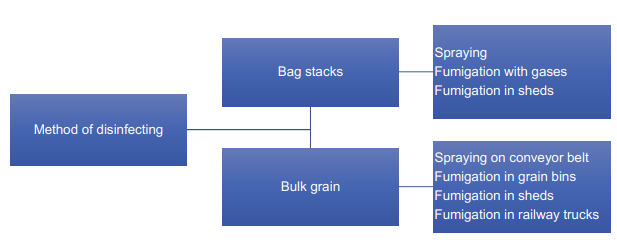
Direct Spraying of Grain
The disinfectant method is exclusively suitable for grain that is received and stored in bulk. The grain is sprayed at intake on the conveyor belt with one of four pesticides. The prescribed dosage of the pesticide must be mixed carefully and dispensed with a special spraying appliance that is calibrated correctly. An overdose will mean that grain is unfit for human use, while a low dosage won’t provide enough protection against insects.
Grain that is sprayed directly must lie 21 days before being dispatched. The concentrate of registered spraying materials must be mixed with water and sprayed onto the conveyor belt with grain while it moves past beneath the nozzle. Dosages are calculated with a formula and can also differ for the various grain types.
Precautionary measures for accurate spraying include:
- Pressure meter may not be higher than 2.7 bar. If the spray is too fine it will drift away from the grain.
- Maximum 2m between spraying point and grain otherwise spray doesn’t get a chance to reach dry kernels.
- Spray as close as possible to the receiving end so that machines are kept clean.
- Daily record is kept of the spray rate and grain flow rate so that not too much or too little is sprayed.
- Use clean water when mixing the spray mixture to prevent the nozzles from clogging.
- Wet grain is sprayed and not the conveyor belt.
- Nozzles spouts and filters must be cleaned daily.
Spraying of Bag Sacks
The equipment used for the bag stacks is a pressure spray (such as back-pack spray or spraying pump) that can spray five liters per minute at a pressure of 17-20 bars. A pressure meter is used to change the spray pressure. The pressure spray also has a filter that prevents residues, grass, sand, dust and other solid materials accidentally entering the tank and causing the pump, pipes or nozzles to clog. When this happens, the filter must be taken out and cleaned.
One of four insecticide formulations will be chosen, and the concentrate mixed with water as per the instructions given. Spraying will be done immediately after fumigation and afterwards at monthly intervals.
Fumigation of Grain in Silo Bins
Grain that is already contaminated at intake should be fumigated as soon as possible. All silo bins must be inspected regularly for potential contamination, such as inspections of the surface area of the grain and at outlet valves.
Grain deep inside the silo bin can be checked by monitoring the temperature thereof continuously at several places by using thermocouples. This inspection is important because insect contamination or mould is always accompanied by a sudden increase in the grain temperature.
Fumigation of Sheds
Some bag-sheds still have upright poles in the shed that carry the roof. That makes the closing of stacks with tarpaulins impossible. Grain is such sheds can only be fumigated by closing the whole shed with fumigation tarpaulins in the same manner as an outside stack.
Fumigation of Rail Trucks
Precautionary measures when rail trucks are fumigated include:
- Place a fumigation card in every steel latch on both sides of the truck indicating that the truck is being fumigated and should not be opened.
- Fumigated trucks must be moved as a unit and the silo manager should be notified.
- The minimum fumigation time before off-loading is 5 days.
- Use gas masks when loading hatches are opened.
- Loading hatches must be left open for at least 15 minutes.
Fumigation of Stacks
The fumigation operator must ensure that the stack has been properly covered. The necessary equipment must be at hand and warning boards must be placed in position. Fumigation tarpaulins must be packed firmly around the stack to ensure that it is gas-tight.
Two methods of packing can be used here:
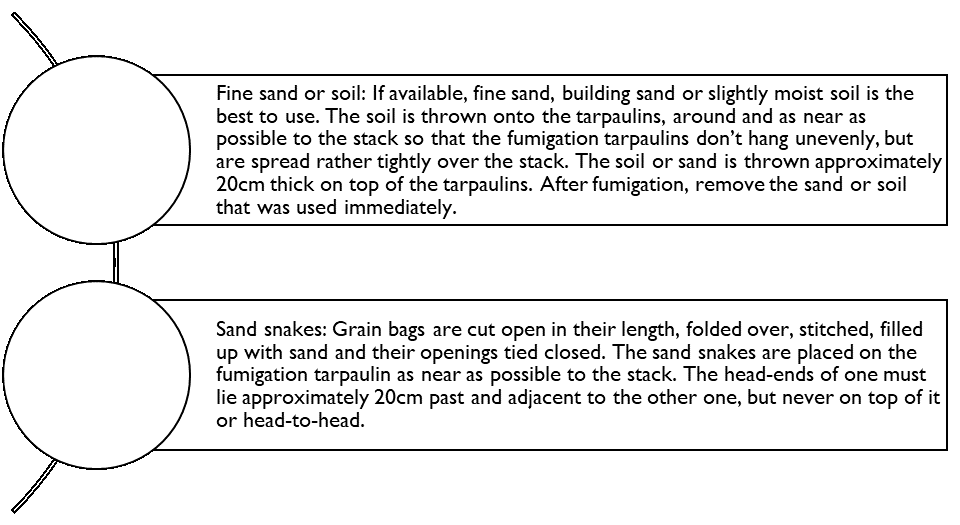
With outside stacks strong winds could the tarpaulins and rolls loose. Precautionary measures can include:
- Place ropes over the breadth of the stack, with half-full bags of sand at the ends, which hang just above the ground. Nets can be used as alternative.
- Rolls must be folded from the side from where the wind blows.
- The excess tarpaulin at the four corners of a stack must be folded neatly around the corners; to which side depends on the wind direction.
Steps in the application of gas:
- Place cylinder with gas on the mass meter which is at standing level.
- Operator and assistant put on gas masks
- Upper head of gas cylinder is unscrewed.
- Determine whether the two valves of the cylinder are closed.
- Unscrew the plugs over the valves and remove them.
The stack is now left as is for the required exposure period after which the tarpaulins are opened by persons wearing gas masks to let the gas out. Thereafter the fumigation tarpaulins are removed and pulled open on another tarpaulin and folded. It is then rolled in the form of a snake in order to carry it without dragging on the ground.
The canals must be closed as quickly as possible otherwise the stack can be infested with insects immediately. The bags that are moved must be sprayed with two residual insecticides. In the case of an outside stack the tarpaulins must be pulled over again and thoroughly fastened.
Fumigation of Bunkers
Prior to fumigation of a bunker there needs to be a thorough inspection of the whole bunker. The inspection is to identify any areas where the level of seal is not of a standard required for fumigation. Areas to inspect include tarps, seams, bulkhead seal and corners of the bunker.
Be sure to check the join or face of the bunker to ascertain whether it is sealed to the correct standard required. Having a poor seal at the front of the bunker may reduce gas concentrations by 40-60%, so it is vital that a good seal is obtained.
The importance of creating a high standard of seal is to maintain the required gas concentration throughout the entire length of the fumigation, and to minimise the risk of leakage around the work site.
Fumigation Record
A record must be kept for every fumigation session with the following information:
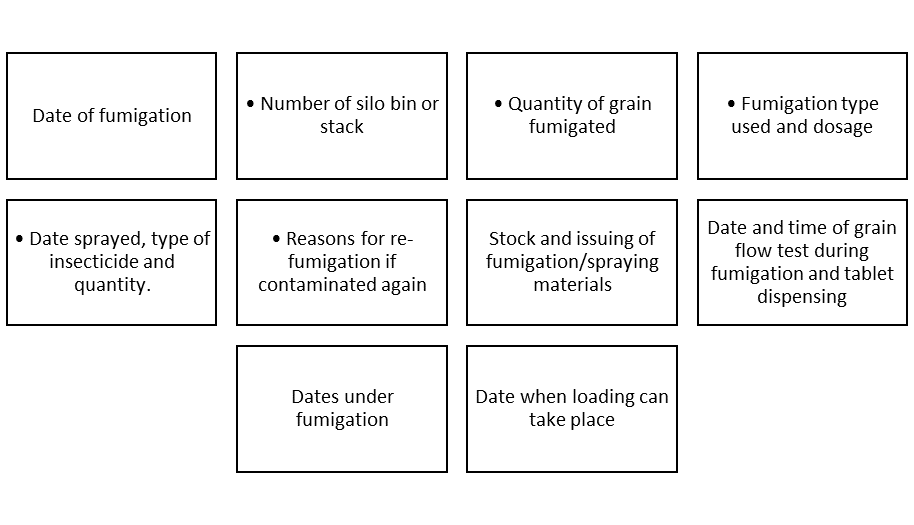
Click here to view a video that explains managing stored grains insects.
Click here to view a video that explains phosphine fumigation demonstration.